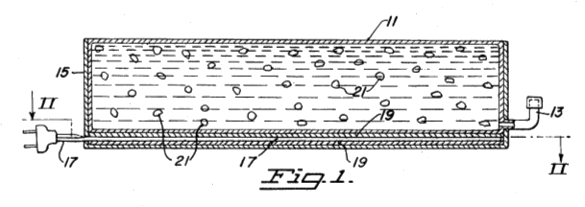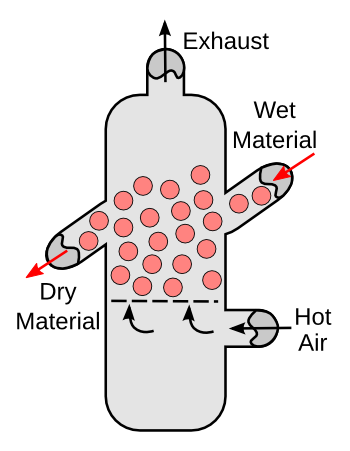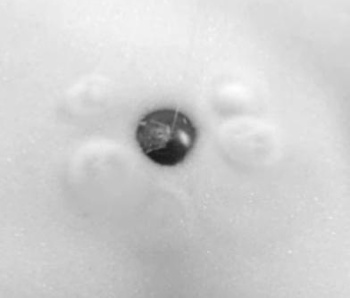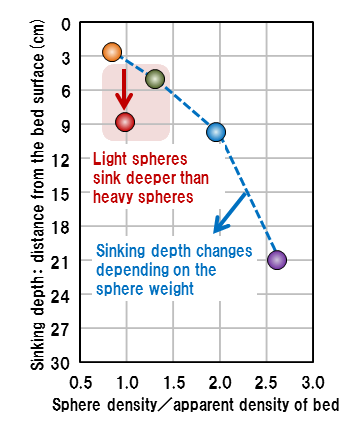Fluidized Beds
June 2, 2016
Nearly everyone of
my generation will assume that an article entitled, "fluidized beds," would be about
water beds. Water beds were popular in the late
1970s through the early
1990s, but they are presently rare. Sales of waterbeds peaked at about 22% of all
mattress sales in the
United States in 1987.
The modern water bed was invented by Charles Prior Hall, who
patented his invention in 1971 (see figure).[1] An essential element of his
design was an
electric heater designed to heat the
water to a
temperature between 85 and 105
°C. As his
patent states, "This heating obviates the cold, clammy feeling normally inherent in fluid filled envelopes."[1]

Fig.1 U.S. Patent No. 3,585,356, "Liquid support for human bodies," by Charles P Hall, June 15, 1971. (Via Google Patents.)
As can be imagined, water beds have had a long
history.
Scottish physician,
Neil Arnott, invented a water bed in 1832 to aid in the
treatment of a
woman having
life-threatening bedsores.[2] Arnott's bed was of simple construction, consisting of a
tub of water, covered with a
rubber-impregnated
canvas, and overlaid with light
bedding. Arnott was also a
popularizer of
physics, having written a general interest
book on
optics and
astronomy in 1864. He also funded a
scholarship for
experimental physics at the university of London.[2]
Science fiction author,
Robert A. Heinlein designed a waterbed after being bedridden with
pulmonary tuberculosis in 1934. His design, as he recalled in his collection of
essays and
short stories,
Expanded Universe, tackled many of the
engineering issues for such a bed, including
temperature control, leak mitigation, and
floor loading, but he never built one. A waterbed is mentioned in his 1961
novel,
Stranger in a Strange Land.
While all this is enlightening, a
fluidized bed is a
technology of a different sort. In its usual form, it's a container filled with a
granular material through which a
pressurized gas is pumped. A
liquid stream can be used, also. Under proper
gas flow conditions, the granular material, which is
fluidized, will behave as if it were a fluid; that is, it can be easily poured and pumped.
It's easy to see how fludization can occur. As gas flow is increased, the particles will start to
levitate. At a critical pressure, the levitating force on a particle will just equal its downward
gravitational force, so the particle will be suspended and will be free to move as a fluid.
Aside from the fact that fluidized solids are easily conveyed, fluidized beds are technologically important for two other reasons; namely, there is excellent
heat transfer from a heat source or
heat exchanger immersed in the bed, and the mixing in a fluidized bed keeps its temperature uniform throughout. The intimate contact between the granular particles and the gas or liquid medium provides excellent heat transfer across the bed, notably to a heat source or a heat exchanger.

Fluidized beds are used for the efficient drying of granular materials.
As can be seen in the illustration, the hot air stream is in contact with the entire surface area of the particles.
The hot air popcorn maker is based on fluidized bed drying.
(Illustration by the author, using Inkscape.)
Since the media in a fluidized bed behaves just like a liquid, objects with a
density higher than that of the bed will sink, and lower density objects will float. For granular particles fluidized with air, the bed density is quite nearly the
product of the
volume fraction of the granular medium and its density.
While investigating such density
segregation in a fluidized bed, a team of
Japanese and
Australian researchers discovered an hitherto unknown
phenomenon. The
interdisciplinary team of two
chemists, a
mechanical engineer, and a
mathematician are from
Okayama University (Okayama, Japan),
Osaka University, (Osaka, Japan), the
University of Melbourne (Parkville, Australia), and the
Swinburne University of Technology (Hawthorn, Australia). They discovered that a bed in its apparently "fixed bed"
regime at low gas flow rates still has the property that dense objects sink.[3-4]

That sinking feeling.
A sphere sinking in a fluidized bed in its fixed bed regime. Local bubbling around the spheres, as shown, occurred when the density ratio was less than 1.3.
(Okayama University, Osaka University, University of Melbourne and Swinburne University of Technology image.)
It appears that the presence of spheres, such as the one shown above, locally fluidizes a supposedly rigid bed, allowing the formation of
voids and
percolation bubbles that enable the spheres to sink at a rate slower than for a fluidized bed, but deeper than expected.[3] The final depth to which a sphere sinks varied with the sphere density and air velocity, and spheres with smaller densities sank more deeply than denser spheres when the sphere density was close to the powder bed density (see graph).[4]

Sinking depth as a function of sphere density.
This presentation of the data from the press release was somewhat confusing to me. However, the journal article is paywalled at $25, which is a steep price to pay for enlightenment.
(Okayama University, Osaka University, University of Melbourne and Swinburne University of Technology image.)
Although the process is slow, it has the ability to
segregate particles by density within the fixed bed.[3-4] This might be an advantage over a standard fluidized bed, which can just sort floating and sinking particles.[4] As shown in the graph, you need to be within 85% of the air velocity required for fluidization to see this effect.

Sinking depth as a function of gas velocity.
You need to be within 85% of the fluidization velocity for this effect.
(Okayama University, Osaka University, University of Melbourne and Swinburne University of Technology image.)
![]()
References:
- Charles P Hall, "Liquid support for human bodies," U.S. Patent No. 3,585,356, June 15, 1971.
- Lives of the fellows: Munk's Roll : Volume III : Neil Arnott, Royal College of Physicians.
- Jun Oshitani, Toshiki Sasaki, Takuya Tsuji, Kyohei Higashida, and Derek Y. C. Chan, "Anomalous Sinking of Spheres due to Local Fluidization of Apparently Fixed Powder Beds," Phys. Rev. Lett., vol. 116, Document No. 068001 (February 11, 2016), DOI:http://dx.doi.org/10.1103/PhysRevLett.116.068001.
- Anomalous sinking of spheres in apparently fixed powder beds discovered, Osaka University Press Release no. 2016-2-1, May 2, 2016.
Permanent Link to this article
Linked Keywords: Baby boomer; my generation; waterbed; water beds; 1970s; 1990s; mattress; United States; patent; patented; design; electric heating; electric heater; water; temperature; Celsius; °C; Google Patents; history; Scottish; physician; Neil Arnott<; medical case management; treatment; woman; disease; life-threatening; pressure ulcer; bedsore; bathtub; tub of water; natural rubber; canvas; bedding; popular science; popularizer; physics; book; optics; astronomy; scholarship; experimental physics; science fiction; author; Robert A. Heinlein; pulmonary tuberculosis; essay; short story; Expanded Universe; engineering; temperature control; structural load; floor loading; novel; Stranger in a Strange Land<; fluidized bed; technology; granular material; pressure; pressurized; gas; liquid; airflow; gas flow; fluidization; fluidize; levitation; levitate; gravitational force; heat transfer; heat exchanger; efficient energy use; drying; granular material; surface area; popcorn maker; Inkscape; density; product; volume fraction; segregation; Japan; Japanese; Australia; Australian; research; researcher; phenomenon; interdisciplinarity; interdisciplinary; chemist; mechanical engineering; mechanical engineer; mathematician; Okayama University (Okayama, Japan); saka University, (Osaka, Japan); University of Melbourne (Parkville, Australia); Swinburne University of Technology (Hawthorn, Australia); regime; sphere; fluidized bed; bubble; bubbling; ratio; void; percolation; data; press release; scientific journal; journal article; paywall; paywalled; Age of Enlightenment; enlightenment; velocity; Charles P Hall, "Liquid support for human bodies," U.S. Patent No. 3,585,356, June 15, 1971.